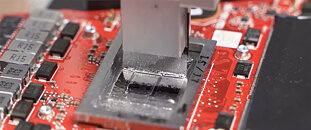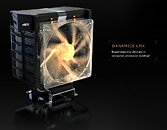
Gigabyte Confirms It'll use Liquid Metal TIM on Some of its RTX 5090 and RTX 5080 Graphics Cards
In an FAQ on its website, Gigabyte has confirmed that the company will use liquid metal thermal interface materials on some of its RTX 5090 and RTX 5080 cards. The cards in question are its Aorus Xtreme Waterforce cards, all of which will be using a liquid gallium based TIM that the company claims will offer up to 10 times heat transfer coefficent compared to what the company refers to as traditional thermal grease. However, it's unclear if the traditional thermal grease is simple silicone based TIM or something more modern. The cards in question are the GV-N5090AORUSX W-32GD, GV-N5080AORUSX W-16GD and GV-N509DAORUSX W-32GD.
In addition to those three cards, the company has a further seven Aorus Master cards that will use what Gigabyte refers to as a "composite metal grease that includes metal particles, to deliver enhanced thermal conductivity performance", which simply sounds like a modern, higher-end TIM. However, the FAQ specifically states that both materials are "fluid-like" in room temperature and above, it seems like Gigabyte is using something a bit different here, rather than your run-of-the-mill thermal paste, since only a few TIM's are runny in room temperature. The company further points out that both TIM's are electrically conductive, so for those planning on swapping out the cooler on their cards, this is something to pay attention to. Gigabyte also points out that it's using a "quadruple protection system to prevent possible short-circuiting of important components" and goes on to point out that if the cooler is removed, at least a couple of these protections will be damaged and will no longer hold the TIM in place. The Aorus Master models are the GV-N5090AORUS M-32GD, GV-N5090AORUS M-32GD, GV-N5090AORUSM ICE-32GD, GV-N509DAORUS M-32GD, GV-N509DAORUSM ICE-32GD, GV-N5080AORUS M-16GD and GV-N5080AORUSM ICE-16GD.
In addition to those three cards, the company has a further seven Aorus Master cards that will use what Gigabyte refers to as a "composite metal grease that includes metal particles, to deliver enhanced thermal conductivity performance", which simply sounds like a modern, higher-end TIM. However, the FAQ specifically states that both materials are "fluid-like" in room temperature and above, it seems like Gigabyte is using something a bit different here, rather than your run-of-the-mill thermal paste, since only a few TIM's are runny in room temperature. The company further points out that both TIM's are electrically conductive, so for those planning on swapping out the cooler on their cards, this is something to pay attention to. Gigabyte also points out that it's using a "quadruple protection system to prevent possible short-circuiting of important components" and goes on to point out that if the cooler is removed, at least a couple of these protections will be damaged and will no longer hold the TIM in place. The Aorus Master models are the GV-N5090AORUS M-32GD, GV-N5090AORUS M-32GD, GV-N5090AORUSM ICE-32GD, GV-N509DAORUS M-32GD, GV-N509DAORUSM ICE-32GD, GV-N5080AORUS M-16GD and GV-N5080AORUSM ICE-16GD.
































